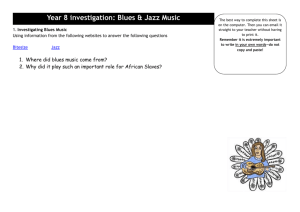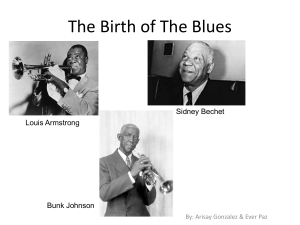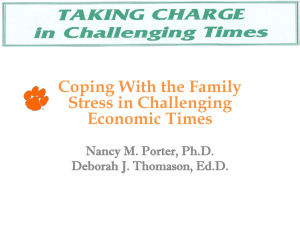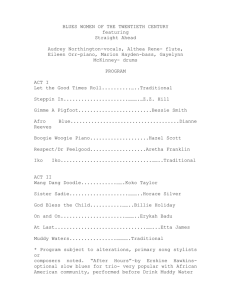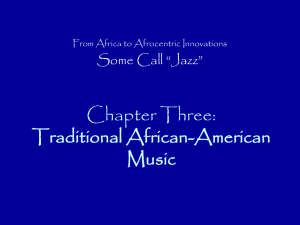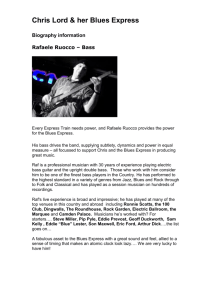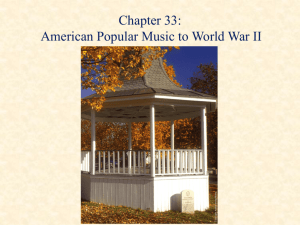Music 3500: American Music 50 questions-
advertisement
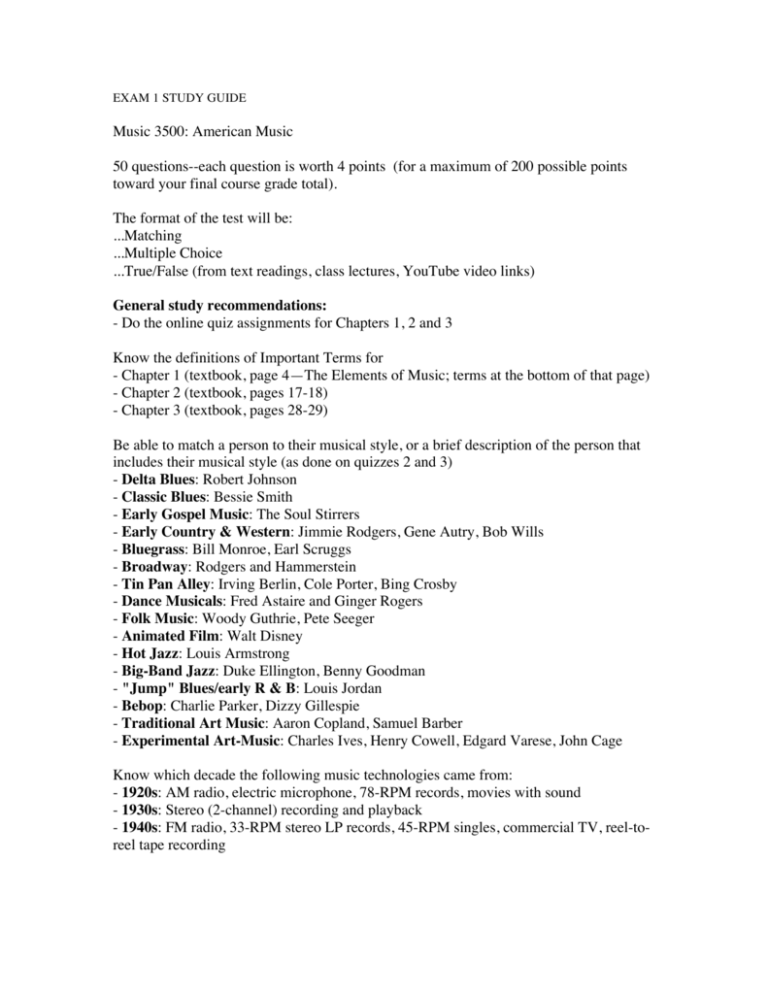
EXAM 1 STUDY GUIDE Music 3500: American Music 50 questions--each question is worth 4 points (for a maximum of 200 possible points toward your final course grade total). The format of the test will be: ...Matching ...Multiple Choice ...True/False (from text readings, class lectures, YouTube video links) General study recommendations: - Do the online quiz assignments for Chapters 1, 2 and 3 Know the definitions of Important Terms for - Chapter 1 (textbook, page 4—The Elements of Music; terms at the bottom of that page) - Chapter 2 (textbook, pages 17-18) - Chapter 3 (textbook, pages 28-29) Be able to match a person to their musical style, or a brief description of the person that includes their musical style (as done on quizzes 2 and 3) - Delta Blues: Robert Johnson - Classic Blues: Bessie Smith - Early Gospel Music: The Soul Stirrers - Early Country & Western: Jimmie Rodgers, Gene Autry, Bob Wills - Bluegrass: Bill Monroe, Earl Scruggs - Broadway: Rodgers and Hammerstein - Tin Pan Alley: Irving Berlin, Cole Porter, Bing Crosby - Dance Musicals: Fred Astaire and Ginger Rogers - Folk Music: Woody Guthrie, Pete Seeger - Animated Film: Walt Disney - Hot Jazz: Louis Armstrong - Big-Band Jazz: Duke Ellington, Benny Goodman - "Jump" Blues/early R & B: Louis Jordan - Bebop: Charlie Parker, Dizzy Gillespie - Traditional Art Music: Aaron Copland, Samuel Barber - Experimental Art-Music: Charles Ives, Henry Cowell, Edgard Varese, John Cage Know which decade the following music technologies came from: - 1920s: AM radio, electric microphone, 78-RPM records, movies with sound - 1930s: Stereo (2-channel) recording and playback - 1940s: FM radio, 33-RPM stereo LP records, 45-RPM singles, commercial TV, reel-toreel tape recording Know the dates of these major US events: 1917-18: US enters World War I 1919: Prohibition (18th Amendment) 1920: US Women get the right to vote (19th Amendment) 1929: The Stock Market crash that initiated the Great Depression 1941-45: US fights in World War II Know the following: - Franklin Delano Roosevelt (FDR): The only US President elected to four consecutive terms - Theodore Roosevelt: Oversaw the US expansion to 48 states, and the completion of the Panama Canal - Flappers: Radical young US women in the 1920s who smoked, and had short bobbed hair and relatively short skirts Music Examples to Study: These will be used as the basis for - Five multiple-choice "Listening Identification" questions, and - A set of questions for matching a person to a musical work Examples for Roots music Folk Song Woody Guthrie: This Land is Your Land (1940) Examples for Popular Music 1900-29 Ragtime piano music Scott Joplin: The Entertainer (1902) "Delta" Blues (Commercial Blues) Robert Johnson: "Cross Road Blues" (1936)—see lyrics Jazz: - Dixieland Jazz: Louis Armstrong: Hotter Than That (1927) - Big Band Swing: Duke Ellington: It Don't Mean a Thing If It Ain't Got That Swing (1931) -­‐ Bebop: Charlie Parker and Dizzy Gillespie: Koko (1945) Jump Blues (early R & B) Louis Jordan and His Tympany Five: Caldonia (1945) Early "Country & Western" Music Jimmie Rodgers: "Blue Yodel No. 8--Muleskinner Blues" (1930)—see lyrics Country & Western Music Bob Wills and the Texas Playboys: New San Antonio Rose (1944)--"Western Swing" Broadway Musicals Kern and Hammerstein: "Ol' Man River" from Showboat (1927)—see lyrics Rodgers & Hammerstein: "Some Enchanted Evening" from South Pacific (1949) Examples for Classical Art-Music Music 1900-29 Charles Ives: The Unanswered Question (1908) Henry Cowell: The Banshee (1925) Aaron Copland: "Simple Gifts" from Appalachian Spring (1944)-Ballet John Cage: "The Perilous Night" from Sonatas for Prepared Piano (1948)



